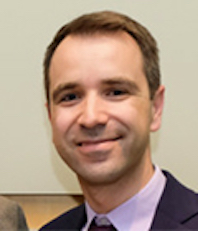Q & A with Dr. Hervé Tiriac
 Precision Medicine hinges on the ability to treat not only specific areas of the body, but the precise biological underpinnings that differentiate one person’s disease from another. This month, we speak with our Division of Surgical Oncology’s Hervé Tiriac, PhD, about his work with organoids — 3D models made from patient-derived tissue that serve as a “patient avatars in a dish.”
Precision Medicine hinges on the ability to treat not only specific areas of the body, but the precise biological underpinnings that differentiate one person’s disease from another. This month, we speak with our Division of Surgical Oncology’s Hervé Tiriac, PhD, about his work with organoids — 3D models made from patient-derived tissue that serve as a “patient avatars in a dish.”
What is an organoid and how do you create/obtain them?
Organoids are three-dimensional models made from healthy or diseased tissues. Organoids can be created from a biopsy or tissue obtained from surgery. These organoids will continue to grow outside of the patient. When an organoid is made from healthy tissue, it can mimic normal organ functions in a dish. When we generate an organoid from a disease such as cancer, the organoids can serve as avatars for the patients’ tumors, helping us find drug treatments that may be more effective.
How are you making use of organoids in your research?
I study pancreatic cancer, which is a difficult disease to study because of the limited availability of patient-derived research models. Organoids allow me to generate patient-avatars in a dish for my own studies, but can also serve as a resource to the larger research community. I am particularly interested in how cancer organoids become drug-resistant, as it is a critical problem for pancreatic cancer patients for whom standard treatment most often does not work. Organoids enable me to test new drugs and identify promising treatment strategies. Finally, I use organoids to uncover the unique features of pancreatic cancer that may represent new vulnerabilities that can be treated with targeted therapy.
How can organoids benefit surgeons and/or patients?
Both surgeons and patients could benefit from organoid technology. For patients, the organoids represent personalized avatars that clinicians and researchers can study in the laboratory to identify effective treatment options. Importantly, we can also determine if certain treatments are ineffective in a specific patient-derived organoid and potentially avoid toxic side-effects. For clinicians and researchers, organoids are a renewable source of tissue that will facilitate cutting-edge research for many years. For many diseases, organoids are accelerating the discovery of effective treatments.
What is the future potential for the use of organoids in surgical research?
In the future, it may be possible to generate an organoid for every patient. Organoids are also a renewable resource that complements existing biorepositories and greatly facilitates clinical research. To achieve this vision, organoid technology and protocols must be optimized and standardized. Importantly, the use of organoids as a tool for patient care must be thoroughly validated in carefully designed clinical trials.
What do you wish more people knew about organoids?
People should know that organoid technology is robust for some organs and diseases, enabling clinicians and researchers to incorporate these next-generation models in their studies. But, organoid methods have not yet been adapted for every tissue type. Therefore, additional work is necessary. Further, clinical-trial validation of patient-derived organoids is underway for many diseases and are critical to determine the value of adding organoid models to patient care.
What are some misconceptions about organoid research?
Like any model, organoids have advantages and limitations. Currently, organoids are excellent models for the identification of novel pathways and biological functions of specific tissue types and diseases. In cancer research specifically, organoids capture the disease heterogeneity observed in patients and therefore these models are well suited for drug discovery. However, the incorporation of additional cell types in organoid cultures increases the complexity of the model and remains a hurdle for researchers attempting to mimic cellular interactions in a dish. Finally, organoids are a relatively new tool for clinical research, and therefore they are expensive to establish and maintain.
Where do you see your research headed in the next 5-10 years?
In the long term, I expect our research will uncover novel vulnerabilities of pancreatic cancer cells that clinicians will be able to exploit to treat this deadly disease. In the shorter term, we are focused on first identifying novel therapeutic targets in treatment-refractory pancreatic cancer organoids and secondly, we are refining organoid methods to accelerate translational research so we can achieve our long-term goals. The collaborative nature of our work has been key to our successes and we will rely on a continuing partnership with our colleagues in the clinic and in the laboratory to achieve our ambitious goals.
